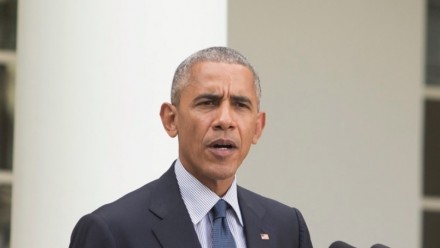Paris climate agreement comes into force: now time for Australia to step up
This article by Dr Luke Kemp was originally published by The Conversation.
The Paris climate agreement is set to enter into force next month after the European Union and Canada ratified the agreement overnight. The agreement, reached last December, required ratification by at least 55 countries accounting for 55% of global emissions to become operational.
US President Barack Obama hailed the news as perhaps “a turning point for our planet”, but also noted that it “will not solve the climate crisis” alone.
So far, 73 countries accounting for 56% of emissions have ratified the agreement. This includes the world’s two largest emitters: China and the US.
This week the European Parliament approved ratification of the agreement for the EU. The European Council has formally adopted this decision and finalised ratification.
This has put the agreement over the 55% threshold and triggered entry into force. However, by the rules of the agreement, 30 days must now elapse before the agreement becomes operational. The agreement will enter into force on November 4.
This will mean that, from that date, the agreement will be active and legally binding on those who have ratified it.
A sign of ambition?
The Paris Agreement has entered into force unexpectedly quickly. The 1997 Kyoto Protocol had identical entry-into-force conditions. Yet it took eight years for the protocol to move from adoption to entry into force. By comparison Paris looks like a ratification landslide: it will take less than one year.
Why has ratification been so quick?
The optimists would point to this as evidence of mounting international momentum. A truly global agreement and joint ratification by China and the US have reinvigorated international efforts.
India, Canada and the EU have followed shortly after the US and China. Canada also recently announced a domestic carbon tax of C$10.
Ratification is not action per se, though, and it’s difficult to directly link the domestic actions of Canada and others to Paris. The more realistic explanation for the ratification landslide is less inspiring. The Paris Agreement is so weak in terms of legal obligations that countries have little reason not to ratify it.
The legal obligations of the Paris Agreement are sparse and procedural. Countries are bound to submit increasingly stringent pledges every five years. Yet they are not obliged to achieve them.
Countries are bound to provide information about their domestic efforts and keep domestic greenhouse gas accounts. Yet most countries, including Australia, already do so.
Ratifying Paris imposes few additional actions on countries, aside from making a pledge every few years. Not ratifying would make the dissenting country a climate pariah internationally. There is little for parliaments and leaders to debate.
The speed of entry into force may simply betray how little is expected of parties to the pact. It could be a sign of weakness, rather than strength and momentum.
What about Australian ratification?
Australia has yet to ratify the Paris Agreement, but will likely do so soon.
Australian ratification of international treaties is done through the executive, not the parliament. Prime Minister Turnbull makes the final decision as to whether Australia will ratify the Paris Agreement.
Turnbull will not act alone; his decision will be advised by cabinet and the report of the Joint Standing Committee on Treaties (JSCOT). This is a cross-party committee made up of members from the Senate and the House of Representatives.
JSCOT is considering the Paris Agreement and will hold its final public briefing in Melbourne today. Shortly thereafter it will report back to parliament.
Given that Paris implies few obligations, Australia will likely ratify the agreement before the end of the year. Not doing so would unnecessarily risk Australia’s already tattered reputation on climate change.
Yet there are also fears that Australia risks embarrassment by ratifying and then missing its first pledge.
Target troubles
Currently, Australia has made an intended nationally determined contribution (INDC) to reduce emissions by 26-28% on 2005 levels by 2030. If Australia joins the Paris Agreement this would likely become our first pledge under the deal.
But existing modelling suggests we will significantly overshoot this target.
Climate Action Tracker estimates that Australia is instead on track to increase emissions above 27% on 2005 levels by 2030 (this equates to 61% above 1990 levels). They note: “Australia stands out as having the largest relative gap between current policy projections for 2030 and the INDC target.”
Modelling done by Reputex this year supports this. Reputex concludes that existing policy settings will be inadequate for meeting the 2030 targets. More aggressive measures, such as tripling the funding of the Emissions Reduction Fund, would be needed.
There is also evidence that the centrepiece of Australian climate policy – the Direct Action abatement scheme – is not effective. Recent research from Paul Burke of the Australian National University suggests that many of the projects funded by Direct Action are “anyway projects”. These are reductions that would have occurred anyway without government assistance.
Advice provided by the Department of Foreign Affairs and Trade suggested that Australia already has the necessary “legislation, policies and measures” in place to meet its 2030 target. But during a public briefing on the Paris Agreement last week department officials conceded that there was no government modelling to show that Australia will meet its 2030 target.
If Australia were to ratify the Paris Agreement and miss its first target then there would be few ramifications. Technically, parties to Paris are not required to meet their pledges. They only need to pursue domestic measures that aim to achieve submitted pledges.
Even Australia would clear such a low bar.
However, missing the first target would provide ammunition for both domestic and international critics. Mounting pressure from citizens and other world leaders could force the Australian government to change its climate policies. This is the logic of the pledge and review system of the Paris Agreement.
We cannot be certain of how effective this approach would be given recent Australian history. Criticism and public pressure did little to dissuade the federal government under Tony Abbott from abolishing the carbon-pricing system in 2014.
The Paris Agreement entering into force is historic, but how it will be viewed historically is unclear. Does it mark a new era of multilateral action and hope? Or will it mark the finalisation of a diplomatic smokescreen, a legal ribbon around business-as-usual climate policy?











